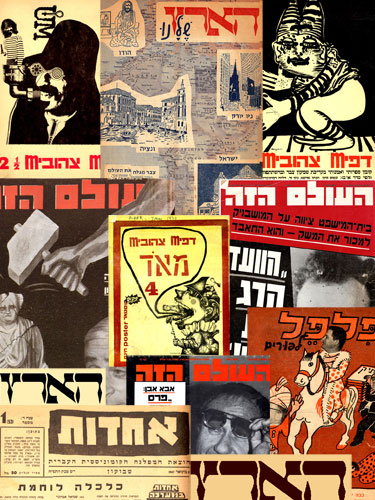
Journalism
Shimon Tzabar worked for the Israeli press from the early 1950s until he left the country in 1967.
He published articles and cartoons in many Israeli newspapers and magazines such as Ha'aretz Shellanu (a children's magazine), La'isha (a women's magazine), Davvar, Ahdut, Dvar Hashavu'a, Al Hammishmar, Bamahanne, Basha'ar, as well as Ha'aretz and Ha'olam Hazze. His early cartoons were collated by him in a small book, Kotzo shel Tzabar (The thorn of Tzabar), which is reproduced here in its entirety (read about his life as a cartoonist in Introduction to cartoons).
His most significant journalistic contributions were for Ha'aretz and Ha'olam Hazze. He was on the payroll of Ha'aretz from May 1954 until July 1960 and again from 1964 until 1967. In 1960 he left Ha'aretz for Ha'olam Hazze (read about his times and experiences in Ha'aretz and Ha'olam Hazze.
In Ha'aretz he published 110 political cartoons, Hadshot Tzabar (Tzabar's News) during 1956, between 1st January and 28th October, one every two or three days; a richly illustrated column, Be'eyney Tzabar (In Tzabar's Eyes) in the Friday supplement from 1954 to 1960 (33 in 1954, 23 in 1955, 23 in 1956, 12 in 1957, 25 in 1958, 8 in 1959 and 16 in 1960); a series of comic strips Hakelev Va'ani (The Dog and I) about the adventures of Shabtay, an extra-terrestrial being from the planet Tzedeq (Justice, which is also the Hebrew name of Jupiter), and his small dog, Pluto, in the Israel of before and after Six Days' War. Shimon also published in Ha'aretz the column Tzabar Hamme'ofef (The Flying Tzabar) from January 1957 to February 1960 (19 in 1957, 23 in 1958, 39 in 1959 and 6 in 1960) which chronicled in words and drawings his travels in Europe, Asia and Africa and which were later collated in two books (see Books section). A selection of columns Shimon published in Ha'aretz between 1962 and 1967 [H] and a selection of the comic strips, Hakelev Va'ani [H] from his output for Ha’aretz are reproduced here.
At Ha'olam Hazze Shimon had a weekly page with a picture, Kotzo shel Tzabar (Thorn of Tzabar) [H]. He also took over (anonymously) the satirical page called Ha'olam Habba (The Next World) [H], edited by 'Lili Galili' and changed it considerably by introducing innovative features, such as readers' participation. A selection of both columns from Ha'olam Hazze is reproduced here.
He was the art editor of Tzipor Hannefesh (Bird of the Soul) during most of the time of its publication. It was a satirical paper that first appeared as a supplement to Yedi'ot Aharonot, and later as an independent publication (read about Tzipor Hannefesh). He was also involved in the publication of Dappim Tzehubim (Yellow Pages), a magazine of art and literature, and edited at least one issue containing contributions of his Israeli contemporaries, as well as pieces by Jonathan Swift, Marquis de Sade and Wallace Ting.
In the aftermath of the Six Days' War, Shimon moved to London, and initiated the publication of Israel Imperial News, a satirical magazine that showed the world the face of Israel that Israel did not want the world to see (see Politics). The two issues of the Israel Imperial News that were published in London with the help of like-minded friends attracted positive and intriguing attention in the British press. However, after two issues, Shimon decided to join forces with members and sympathizers of Matzpen in the publication of Israca (Israeli Revolutionary Action Committee Abroad).
Since he became known in London as a vocal critic of Israel and the occupation, he was commissioned to write an article on the first anniversary of the Six Days' War for the Daily Telegraph, which appeared alongside an article on the same topic, albeit expressing a different view, by Yael Dayan. Later he was approached again by the Daily Telegraph and was asked to do a series of anti-war comic strips, 'Sergeant Pepper', for the Mandrake column. The comic strips were drawn and approved of, but a week before the due publication date the contract was cancelled without explanation. Shimon's activities in London at the time were closely followed by the Israeli press. Ha'aretz, Ma'ariv, Yedi'ot Aharonot, Davvar, Ha'olam Hazze, Pi Ha'aton (magazine of the students' union) all described him as a traitor to his homeland (see Politics).
From time to time during the late 80s and 90s Shimon Tzabar reappeared in the Israeli press. He was written about by Adam Baruch (1989, 1994) [H], Amnon Birman (Yedi'ot Aharonot, Kol Ha'ir) [H] and Nathan Zach (Ha'olam Hazze) [H], and he himself wrote three articles for the supplement of Yediot Aharonot edited by Adam Baruch, about his passion for studying and collecting mushrooms and his expedition to the Siberian Tundra in 1992 (see Mushrooms) [H]. Also noteworthy is his article for Hadashot, an Israeli daily that has since ceased publication, in which he outlined his then daring proposal of a solution to the Palestinian–Israeli conflict in an article titled, Peace Now is Not Enough (see Politics).